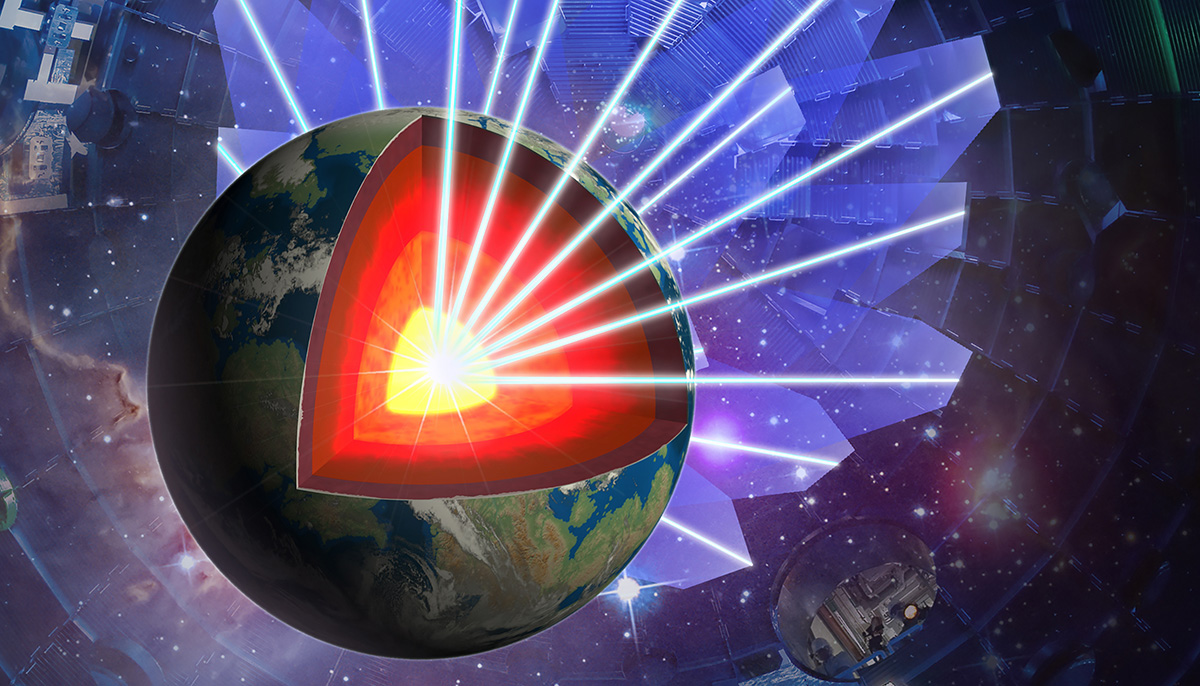Planetary Physics

Probing Planetary Interiors
Some of the most intriguing NIF experiments test the physics believed to determine the structures of planets down to their cores, both in our solar system and beyond.
In particular, scientists are using NIF to “explore” recently discovered exoplanets by duplicating the extreme conditions thought to exist in their interiors. Thousands of extrasolar planets have been identified, some smaller than Earth and others a dozen times more massive than Jupiter.  NIF’s lasers are focused onto a multi-stepped iron sample at the center of the 10-meter-diameter Target Chamber. Experiments measure the equation of state of iron under core conditions of large rocky exoplanets. Credit: Bethany VukomanovicThere is intense scientific interest in understanding how these exoplanets might have formed billions of years ago, the composition of their interiors, and whether they could support an atmosphere or even some form of life.
NIF’s lasers are focused onto a multi-stepped iron sample at the center of the 10-meter-diameter Target Chamber. Experiments measure the equation of state of iron under core conditions of large rocky exoplanets. Credit: Bethany VukomanovicThere is intense scientific interest in understanding how these exoplanets might have formed billions of years ago, the composition of their interiors, and whether they could support an atmosphere or even some form of life.
Limitations to Modeling
Observational data provide only a rough estimate of an object’s size and mass, so scientists must supplement exploration with modeling. This approach, however, has its limitations because models are based on our solar system, and many planetary systems do not closely resemble ours. Accessing densities and temperatures like those deep within planets through lab experiments lets scientists refine their calculations and models to better understand the structure and formation of bodies both distant and close to home.
A major factor in unraveling the interior structure of planets is accurately predicting material behavior, or determining the relevant equations of state, under extreme pressure. Equations of state express the relationship between pressure, temperature, and volume and are used to generate computational models of material behavior.
Squeezing Diamond
NIF experiments designed to replicate the conditions believed to exist in the cores of “super-Earth” extrasolar planets (those 3 to 20 times more massive than Earth) are providing clues to planet formation and structure as well as to the exotic behavior of materials at high densities. Diamond—a form of carbon—is especially interesting to astrophysicists because carbon is the fourth most abundant element in the universe. Icy giant planets such as Neptune and Uranus contain large quantities of methane that decompose at high pressures and temperatures, possibly forming diamond-rich interior layers. Some scientists theorize that large planets like Uranus could have diamond icebergs floating in a methane sea.
Researchers have conducted experiments on NIF in which a sample of diamond was compressed to a pressure of more than 50 million times Earth’s atmospheric pressure. Such conditions are believed to exist in the cores of exoplanets up to 20 times more massive than Earth.
These experiments feature a technique called ramp compression to keep the diamond sample relatively cool—less than 10,000 kelvin (about 9,700°C)—compared with 30 million kelvin in shock compression experiments. With ramp compression, materials remain in solid form at higher pressures than they would in standard, nearly instantaneous shock physics experiments (see Developing New Capabilities).
More Information
“The Materials Scientist Who Studies the Innards of Exoplanets,” Quanta, June 15, 2021
“LLNL Joins New Research on Atom-Changing Pressures,” NIF & Photon Science News, August 27, 2020
“New Way to Study Elements Mixing Inside Giant Planets Could Boost Fusion Research,” NIF & Photon Science News, July 9, 2020
“Studies Provide New Insights into the Formation of ‘Super-Earths,’ NIF & Photon Science News, June, 2018
“Squeezing Iron for Clues About ‘Super-Earth’ Cores,” NIF & Photon Science News, April, 2018“Record Experiments Probe Exoplanetary Cores,” NIF & Photon Science News, April, 2018
“Laser Experiments Illuminate the Cosmos,” Science & Technology Review, December, 2016
“Putting Pressure on Hydrogen,” NIF & Photon Science News, September, 2015
“Nature Cover Story Reports on NIF Experiments Peering Into Giant Planets,” NIF & Photon Science News, July, 2014
Next up: Plasma Physics



